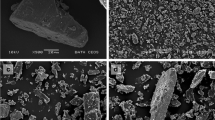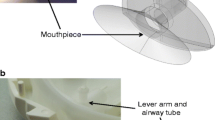Abstract
Purpose. To obtain a quantitative assessment of the cohesive and adhesive force balance within dry powder inhaler formulations.
Methods. The atomic force microscope (AFM) colloid probe technique was used to measure the adhesive and cohesive force characteristics of dry powder systems containing an active component (budesonide, salbutamol sulphate) and α-lactose monohydrate. To minimize the variations in contact area between colloid probe and substrates, nanometer smooth crystal surfaces of the drugs and the excipient were prepared.
Results. The uniformity in contact area allowed accurate and reproducible force measurements. Cohesive-adhesive balance (CAB) graphs were developed to allow direct comparison of the interaction forces occurring in model carrier-based formulations. A salbutamol sulphate-lactose system revealed a significant tendency for the two materials to adhere, suggesting a propensity for the powder to form a homogenous blend. In contrast, the budesonide-lactose system exhibited strong cohesive properties suggesting that the formulation may exhibit poor blend homogeneity and potential for segregation upon processing and handling.
Conclusions. The novel approach provides a fundamental insight into the cohesive-adhesive balances in dry powder formulations and further understanding of powder behavior.
Similar content being viewed by others
REFERENCES
W. C. Hinds. Aerosol technology: Properties, Behaviour and Measurements of Airborne Particles, Wiley, New York, 1999.
N. M. Ahfat, G. Buckton, R. Burrows, and M. D. Ticehurst. Predicting mixing performance using surface energy measurements. Int. J. Pharm. 156:89-95 (1997).
D. Cline and R. Dalby. Predicting the quality of powders for inhalation from surface energy and area. Pharm. Res. 19:1274-1277 (2002).
G. Buckton. Characterisation of small changes in the physical properties of powders of significance for dry powder inhaler formulations. Adv. Drug Deliv. Rev. 26:17-27 (1997).
R. N. Jashnani, P. R. Byron, and R. N. Dalby. Testing of Dry Powder Aerosol Formulations in Different Environmental-Conditions. Int. J. Pharm. 113:123-130 (1995).
V. Berard, E. Lesniewska, C. Andres, D. Pertuy, C. Laroche, and Y. Pourcelot. Dry powder inhaler: influence of humidity on topology and adhesion studied by AFM. Int. J. Pharm. 232:213-224 (2002).
R. Price, P. M. Young, S. Edge, and J. N. Staniforth. The influence of relative humidity on particulate interactions in carrierbased dry powder inhaler formulations. Int. J. Pharm. 246:47-59 (2002).
M. C. Korecki and P. J. Stewart. Adhesion of solid particles to solid surface. A.M.A. Arch. Env. Health 1:13-21 (1987).
J. N. Staniforth, J. E. Rees, F. K. Lai, and J. A. Hersey. Determination of interparticluate forces in ordered powder mixes. J. Pharm. Pharmacol. 33:485-490 (1981).
M. E. Mullin, L. P. Michaels, V. Menon, B. Locke, and M. B. Ranade. Effect of geometry on particle adhesion. Aerosol Sci. Tech. 17:105-118 (1992).
W. A. Ducker, T. J. Senden, and R. M. Pashley. Direct Measurement of Colloidal Forces Using an Atomic Force Microscope. Nature 353:239-241 (1991).
H. Hertz. Study on the contact of elastic solid bodies (SLA translations, SLA-57-1164). Zeitschr. F. Reine Angewandte Mathehmatik 29:156-171 (1881).
K. L. Jonhson, K. Kendall, and A. D. Roberts. Surface energy and the contact of elastic solids. Proc. Roy. Soc. London 324:301-303 (1971).
B. V. Deryaguin, V. M. Müller, and Y. P. Toporov. Effect of contact deformations on the adhesion of particles. J. Colloid Interface Sci. 53:314-325 (1975).
L. R. Fisher and J. N. Israelachvili. Direct measurements of the effect of meniscus forces on adhesion: a study of the applicability of macroscopic thermodynamics to microscopic surfaces. Colloids and Surfaces 3:303-319 (1981).
E. R. Beach, G. W. Tormoen, J. Drelich, and R. Han. Pull-off force measurements between rough surfaces by atomic force microscopy. J. Colloid Interface Sci. 247:84-99 (2002).
U. Sindel and I. Zimmermann. Measurement of interaction forces between individual powder particles using an atomic force microscope. Powder Technol. 117:247-254 (2001).
J. C. Hooton, C. S. German, S. Allen, M. C. Davies, C. J. Roberts, S. J. B. Tendler, and P. M. Williams. Characterization of particleinteractions by atomic force microscopy: Effect of contact area. Pharm. Res. 20:508-514 (2003).
P. G. Royall, D. Q. M. Craig, D. M. Price, M. Reading, and T. J. Lever. An investigation into the use of micro-thermal analysis for the solid state characterisation of an HPMC tablet formulation. Int. J. Pharm. 192:97-103 (1999).
L. Mackin, R. Zanon, J. M. Park, K. Foster, H. Opalenik, and M. Demonte. Quantification of low levels (<10%) of amorphous content in micronised active batches using dynamic vapour sorption and isothermal microcalorimetry. Int. J. Pharm. 231:227-236 (2002).
P. Begat, P. M. Young, S. Edge, J. S. Kaerger, and R. Price. The effect of mechanical processing on surface stability of pharmaceutical powders: Visualization by atomic force microscopy. J. Pharm. Sci. 92:611-620 (2003).
J. Albertsson, A. Oskarrson, and C. Svensson. X-ray Study of Budesonide: molecular structure and solid solution. Acta Crystallogr. B34:3027-3036 (1978).
J.-M. Leger, M. Goursolle, and M. Gadret. Structure Cristalline du Sulfate de Salbutamol [tert-butylamino-2 (Hydroxy-4hydroxymethyl-3 phenyl)-1 Ethanol. 1/2 H2SO4. Acta Crystallogr. B34:1203-1208 (1978).
M. Kurimoto, P. Subramony, and R. W. Gurney. Kinetic Stabilization of Biopolymers in Single-Crystal Hosts: green fluorescent Protein in Alpha-Lactose monohydrate. J. Am. Chem. Soc. 121:6952-6953 (1999).
D. M. Schaefer, M. Carpenter, R. Reifenberger, L. P. Demejo, and D. S. Rimai. Surface Force Interactions between Micrometer-Size Polystyrene Spheres and Silicon Substrates Using Atomic-Force Techniques. J. Adhes. Sci. Technol. 8:197-210 (1994).
D. M. Schaefer, M. Carpenter, B. Gady, R. Reifenberger, L. P. Demejo, and D. S. Rimai. Surface-Roughness and Its Influence on Particle Adhesion Using Atomic-Force Techniques. J. Adhes. Sci. Technol. 9:1049-1062 (1995).
Author information
Authors and Affiliations
Rights and permissions
About this article
Cite this article
Begat, P., Morton, D.A., Staniforth, J.N. et al. The Cohesive-Adhesive Balances in Dry Powder Inhaler Formulations I: Direct Quantification by Atomic Force Microscopy. Pharm Res 21, 1591–1597 (2004). https://doi.org/10.1023/B:PHAM.0000041453.24419.8a
Issue Date:
DOI: https://doi.org/10.1023/B:PHAM.0000041453.24419.8a




